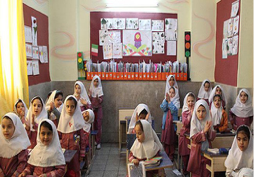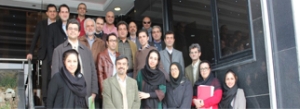Remembering Monir Farmanmaian (1924 –2019)
May 3rd, 2019
 Photo via: Keyhan Life
Photo via: Keyhan Life
Monir Farmanmaian, the Iranian female artist known for her mirror mosaics and geometric patterns passed away on April 20, 2019 at the age of 97 in Tehran. Until recently, I’m ashamed to say, I didn’t know much about Monir, only a cursory knowledge of her and her work through articles and photographs. I only began to learn about Monir, her art and accomplishments, five years ago when I read an extensive article in The New York Times on the exhibit of her work at The Guggenheim Museum.
My appreciation of Iran’s classical and contemporary art has been that of a late bloomer and one that I’ve very recently began to explore, albeit very slowly. My earliest recollection goes back to the first and only decade of my childhood growing up in Iran, where accompanied by my art loving parents I found my young self standing in the spacious but dank and dimly lit basement studio of a struggling artist somewhere in Tehran. There were a few more of these types of visits to artists’ studios around the city, but my first visit to the young artist’s basement showroom is the one I still see in my mind’s eye. My parents supported this artist, whose name I don’t recall, by purchasing a number of his paintings which were displayed on the walls throughout our house. One, which hung in the sitting room where my parents entertained guests, was my most favorite. You could only make out the painting from afar; close-up it was a mashup of colors, soft hues of orange, yellow, blue and sand. Once you pulled back a few steps and sat in the furthest seat in the room, you were able to take in its full beauty, faint silhouettes of a caravan of camels, a ghostly apparition of the bygone days of the Silk Road, floating through the desert as the sun ever slowly dipped and disappeared into the horizon.
As a ten-year old, I had little knowledge and exposure to Iranian culture. My parents seldom, in fact never, listened to Iranian classical, contemporary or pop music. I was exposed to The Beatles, Nat King Cole, Bossa Nova, Jazz, Chopin, Mozart and Beethoven. The films I saw in the cinemas in Iran were mostly foreign, dubbed into Farsi. My mother took me to my first opera when I was eight. It was Puccini’s Turandot at Rudaki Hall in Tehran. My piano teacher took me to my first recital when I was around the same age to hear a talented young pianist from America perform pieces by the masters of western classical music.
I first left Iran at age ten to start school in England. After that my returns to Iran were more of a tourist’s; short stays for a couple of weeks or months during the Christmas and summer holidays. And, at sixteen, I left Iran to study in the U.S. At the time, I didn’t know that it would be the last time I’d see Iran, my home, and many of my relatives. I didn’t know that my departure was permanent.
There’s something that happened to me as a young woman leaving Iran, first for England and then for America. I started to detach and let go of that which identified me with my place of origin so that I could acclimate, blend and fit in at my new home. What little I knew of Iran’s rich cultural history, I let go of.
Monir Farmanmaian, née Monir Shahroudy, didn’t let go and didn’t detach. Instead, she embraced her Iranian heritage and culture and infused her art with it.
Monir was born in 1924 in Qazvin, Iran to progressive parents who supported and encouraged her education. After her father was elected to parliament in 1932, the family moved to Tehran. Her love for art began at an art class she took in school once a week. She’s noted to have said that she found it “more fun than math.” After graduating from high school, Monir enrolled at the University of Tehran, Faculty of Fine Arts.

University of Tehran, Faculty of Fine Arts
In 1944, at the height of WWII, Monir together with her brother, her fiancée and his friend, left Allied-occupied Iran on a British liner bound for Bombay (today, Mumbai), India. They then boarded an American naval ship that took them as far as San Pedro, California, and after four days and three nights of traveling across the U.S., they arrived in New York.
She continued her education at Cornell University and Parson’s School of Design. We may say that Monir was the first Iranian student to come to the U.S. to study during WWII.
After college, she worked as a fashion illustrator and graphic designer. She even created the Persian-violet trademark for Bonwit Teller, the luxury department store in NYC. At Bonwit Teller, Monir crossed paths with none other than Andy Warhol who at the time was working as a shoe illustrator.

In New York, Monir’s social circle included artists like Jackson Pollock, Mark Rothko, Willem de Kooning, Andy Warhol, Joan Mitchell, Alexander Calder, Frank Stella, to name a few. In the early 1950s, she used to visit the Guggenheim museum when it was still in a townhouse and known as the Museum of Non-Objective Painting. She was also there in 1956, the day when ground was broken for Frank Lloyd Wright’s concrete spiral.
Her first marriage to an Iranian artist with whom she had migrated to the U.S. seemed to have stifled her creativity. It was only after they had divorced that Monir truly came to her own. After her divorce she returned to Iran. It had been 12 years since she had left and she was wary of returning, not sure of what to expect. She remarried Abol Farmanfarmaian, a man from an aristocratic family, whom she knew of her time living in New York. Back at her homeland, and in a happy marriage, Monir began to flourish as an artist. Inspired by the Persian art of mirror mosaics, known as ayeneh-kari, Monir began to explore the use of this medium and fusing together Islamic patterns and modern abstract geometric shapes and design that soon became her signature creations.
In 1958, she won a gold medal for her display at the Iran Pavilion at the Venice Biennale. In 1963, she had her first solo exhibition at a gallery in Tehran.

Monir’s rising star as an artist was halted by the Iranian Revolution of 1978-1979. She and her husband left for NY soon after. Her art collection in Iran was confiscated by the government. America in 1979 was not as welcoming as when she had first arrived in 1944. The Iranian Revolution, the US Embassy hostage crisis, and then September 11, had placed anyone of Iranian and Middle Eastern origin in the Axis of Evil camp. Monir was turned away by galleries. No one was interested in her work. In NY, she continued creating her mirror mosaics and reverse glass paintings, mostly for herself and friends. After 25 years of living in self-imposed exile in NY, Monir and her husband returned to Iran. She was allowed to open a studio. Soon, she began receiving commissions one of which included a piece for the opening of the Jameel Gallery of Islamic Art at London’s Victoria and Albert Museum in 2006. Another was a permanent six-panel installation in 2009 at the Queensland Art Museum in Brisbane, Australia. The Iranian director, Bahman Kiarostami, premiered his documentary Monir in 2014. (For a clip of Bahman Kiarostami’s documentary Monir, click here.)
In 2015, at age 93, almost 60 years after Monir had first visited the Guggenheim in its original townhouse, she had her first comprehensive retrospective of her work in the United States. The exhibition “Monir Shahroudy Farmanfarmaian: Infinite Possibility: Mirror Works and Drawings 1974–2014” was held at the Solomon R. Guggenheim Museum in New York City.
If we ever find ourselves questioning the viability of international education and the intangible benefits of student exchange programs and access to higher education, we need to remind ourselves of the real life stories of people like Monir Farmanfarmaian and those who came before and after. The trajectory of Monir’s life, from the town of Qazvin, Iran, to the capital city of Tehran, and then New York, and back to Tehran is as depicted in her beautiful mirror mosaics. Fused together, it is a reflection of the richness and vibrancy of her own dual education, global experiences and those of her cultural heritage.
Additional Reading & References:
http://www.reorientmag.com/2015/01/monir-farmanfarmaian/
http://islamicartsmagazine.com/magazine/view/the_third_line_at_abu_dhabi_art/
http://p-l-us.com/en/monir-farmanfarmaian/

Jasmin Saidi-Kuehnert is the President and CEO of the Academic Credentials Evaluation Institute (ACEI).
The Academic Credentials Evaluation Institute, Inc. (ACEI), was founded in 1994 and is based in Los Angeles, CA, USA. ACEI provides a number of services that include evaluations of international academic credentials for U.S. educational equivalence, translation, verification, and professional training programs. ACEI is a Charter and Endorsed Member of the Association of International Credential Evaluators. For more information, visit www.acei-global.org.





























